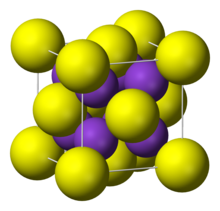Caesium sulfide
 From Wikipedia the free encyclopedia
From Wikipedia the free encyclopedia
 | |
| Names | |
|---|---|
| IUPAC name Cesium sulfide | |
| Identifiers | |
3D model (JSmol) | |
| ChemSpider | |
PubChem CID | |
CompTox Dashboard (EPA) | |
| |
| |
| Properties | |
| Cs2S | |
| Molar mass | 297.876 g/mol |
| Appearance | White crystal |
| Density | 4.19 g·cm−3[1] |
| Melting point | 480 °C[2] |
| Hydrolyzes to form caesium bisulfide[3] | |
| Solubility in ethanol and glycerol | Soluble |
| Structure | |
| cubic, anti-fluorite | |
| Hazards | |
| Occupational safety and health (OHS/OSH): | |
Main hazards | toxic |
| GHS labelling: | |
  | |
| Danger | |
| H314, H400 | |
| P260, P264, P273, P280, P301+P330+P331, P303+P361+P353, P304+P340, P305+P351+P338, P310, P321, P363, P391, P405, P501 | |
| Related compounds | |
Other anions | Caesium oxide Caesium selenide Caesium telluride Caesium polonide |
Other cations | Lithium sulfide Sodium sulfide Potassium sulfide Rubidium sulfide Francium sulfide |
Except where otherwise noted, data are given for materials in their standard state (at 25 °C [77 °F], 100 kPa). | |
Cesium sulfide is an inorganic salt with a chemical formula Cs2S. It is a strong alkali in aqueous solution. In the air, cesium sulfide emits rotten egg smelling hydrogen sulfide.
Production
[edit]Similar to sodium sulfide, anhydrous cesium sulfide can be produced by reacting cesium and sulfur in THF. It needs ammonia or naphthalene to react.[4]
- 2 Cs + S → Cs2S
By dissolving hydrogen sulfide into cesium hydroxide solution, it will produce cesium bisulfide, then it will produce cesium sulfide too.[5][6]。
- CsOH + H2S → CsHS + H2O
- CsHS + CsOH → Cs2S + H2O
References
[edit]- ^ Sommer, Helmut; Hoppe, Rudolf. The crystal structure of cesium sulfide and a remark about cesium selenide, cesium telluride, rubidium selenide, and rubidium telluride (in German). Zeitschrift für Anorganische und Allgemeine Chemie, 1977. 429: 118-30. ISSN 0044-2313
- ^ Dale L. Perry, Sidney L. Phillips: Handbook of inorganic compounds. CRC Press, 1995, ISBN 978-0-8493-8671-8, S. 336 ([1], p. 336, at Google Books).
- ^ Jean D'Ans, Ellen Lax: Taschenbuch für Chemiker und Physiker. 3. Elemente, anorganische Verbindungen und Materialien, Minerale, Band 3. 4. Auflage, Springer, 1997, ISBN 978-3-5406-0035-0, S. 692 ([2], p. 692, at Google Books).
- ^ J.-H. So and P. Boudjouk (1992). N. G. Russell (ed.). "Hexamethyldisilathiane". Inorganic Syntheses. 29: 30–32. doi:10.1002/9780470132609.ch11. ISBN 978-0-470-13260-9.
- ^ Biltz, Wilhelm; Wilke-Dörfurt, Ernst (1905). "Über Sulfide des Rubidiums und Cäsiums". Zeitschrift für Anorganische Chemie. 48: 297–318. doi:10.1002/zaac.19060480122.
- ^ R. Abegg, F. Auerbach: 'Handbuch der anorganischen Chemie'. Verlag S. Hirzel, Bd. 2, 1908. S. 430.Volltext